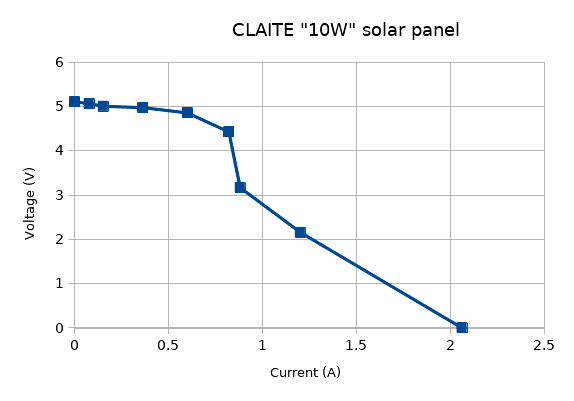Comparison of CLAITE 10W and SE05 5W solar panels
I tested the SE05 "5W" 5V solar panel in 2016:
https://bkhome.org/light/solar/panels-small-2016.htm
I recently purchased the CLAITE "10W" 5V solar panel:
https://bkhome.org/news/202103/10w-solar-panel-for-usb-charging.html
It has been cloudy recently, but today the clouds cleared, just a bit
of faint mistiness, so did a quick comparison of these two panels.
Date is April 5, 2021, 1.00pm, fairly clear sunny sky, solar
intensity reading is 830W/m2, ambient temperature is 30 degC -- Autumn,
but quite a warm day. Negligible breeze.
I used resistances to place different loads on the panels, and plotted voltage-current graphs. Here is the CLAITE "10W" panel:

Here is the graph of the SE05 "5W" panel:

...in the latter graph, see the foldback effect, which I think is a very good feature.
For the SE05, the peak power point is about 4.78V @ 0.59A, which is
2.8W. For the CLAITE panel, peak power is only about 4.86V @ 0.6A, which
is 2.9W. You see why I am putting those "5W" and "10W" ratings in
quotes!
Hmmm, it seems that the CLAITE panel is throttling its output. It has
a short-circuit current of 2.16A, which is an indicator that this panel
potentially has a much higher peak power point.
I did a quick test connecting the CLAITE panel to two Android phones,
and got 0.52A and 0.57A. My 2016 post explains D+ and D- pin
connections required for Android phones. Shorting D+ and D- together
made no difference.
Measuring the resistances between the GND, D+, D- and 5V pin on the
USB socket, there are resistors connected to D+ and D-, indicating this
panel is designed to charge Apple devices, not Android devices. Here is
information for Apple devices:
https://www.instructables.com/Modify-a-cheap-USB-charger-to-feed-an-iPod-iPhone/
https://learn.adafruit.com/minty-boost/icharging
Anyway, connections of the D+ and D- pins does not matter when just
applying resistance loads, as I did for the above graphs. The regulator
in the CLAITE panel is throttling the output. It should not be doing
that.
It looks like I will have to sacrifice this panel, see if can open up
that regulator, maybe replace with my own that I built in 2016 -- see
link at top of this post.
EDIT 2021-04-06:
Today, just after 11am, I noticed that the clouds had cleared, just some
wispy clouds off to the sides, but quite intense blue overhead. Did a
very quick test with the CLAITE panel, time 11.30am, April 6, 2021,
Perth, Western Australia, sun intensity 885w/m2, ambient temperature 27
degC. Negligible breeze.
I did this very quickly, didn't allow the panel
to completely warm up in the sun. Just brought it out from inside,
aimed it at the sun, running through an inline voltage-current digital
meter, and wrote down the readings.
Charging my Huawei phone, a 2019 model that I
actually purchased early 2020 (so I escaped the Google embargo), battery
was at 93% and the charging was 4.90V @ 0.78A, which is 3.82W.
Then plugged in my Voltaic V15 battery bank, which is approximately 50% charged, and read 5.05V @ 0.62A, which is 3.13W.
I expected better with the stronger sunlight, but those reading are nowhere near the claimed 10W!
I need to find out what the panel is actually
capable of, without the regulator getting in the way. I used a serrated
kitchen knife to cut the plastic covering, exposing the regulator:

...at the bottom are the two tabs from the
panel, so I should be able to remove the regulator and solder directly
to those tabs. The glue is flexible, probably a silicone sealant, so
should be able to pry the board off.
The main chip is "XL1410E1" and on the next line "01103". Would be interesting to find the specs on it.
EDIT 2021-04-14:
Here is a more accurate test of the CLAITE "10W" solar panel:
https://bkhome.org/news/202104/accurate-test-of-claite-10w-5v-solar-panel.html
...hikers, note the comment about the switching regulator!
Tags: light
